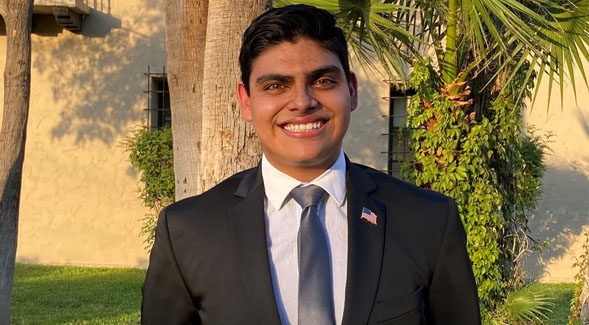Researching Cultural Diversity in the Imperial Valley
Senior Carlos Fitch hopes to portray cultural aspects and opportunities in the borderland.

Undergrad Research Spotlight: This is part of a series on undergraduate research opportunities at SDSU and the programs that help support a future pipeline of scientists from diverse and underrepresented groups. Stories in this series include a microbiology researcher and an engineering researcher.
When Carlos Fitch took a History of Imperial-Mexicali Borderlands course last year at San Diego State University Imperial Valley, he chose to focus his class project on early Chinese settlers in the valley. What started out as a pursuit for a good grade turned into a dedicated study of borderland culture and political effects on minorities.
A borderland native, Fitch was born in Brawley, in the low desert region of Imperial Valley, two hours east of San Diego. Raised in Mexicali just 10 miles south of the U.S.-Mexico border, he moved back stateside and lived with his aunt in the Imperial Valley to attend Calexico High School at the age of 15.
A first-generation college student, Fitch is now president of Associated Students at SDSU-IV, while double majoring in history and Spanish.
Fitch grew up hearing about early Chinese immigrants who settled in the Imperial Valley. He took advantage of this research opportunity to explore the correlation between early anecdotal stories and xenophobia and racism in both Mexico and the U.S.
Fascinated by Chinese mythology and stories of the Imperial Valley and Mexicali, Fitch continued his class research, sharing it with his mentor, professor Gilberto Reyes. After presenting his project at the SDSU Student Research Symposium in the spring, he was referred to assistant professor of education Lluliana Alonso, who coordinates the faculty-student mentoring program in the Division of Undergraduate Studies.
A rising senior, Fitch hopes to continue his education at the SDSU San Diego campus after graduation, where he plans to get a master’s degree in educational leadership, hoping to one day become a college administrator.
“I am proud and honored to be Carlos’s mentor,” Reyes said. “Not only is he going to be a great historian and Chicanx scholar, but he is also on his way to becoming a young academic leader that the borderland needs. His approach on topics such as immigrants and LGBTQ+ rights has proven that he cares not only about the historiography of the silent voices of the community, but also acknowledges them by giving them a voice too.”
The SDSU News Team spoke with Fitch about what he learned, and what’s coming next.
Tell us about your class project on the Chinese community in the Imperial Valley.
The class was focused on the history of the creation of the Imperial Valley in the relation that it has with Mexicali Valley. Our final project was to do a 15-page research paper on a topic of our choice. I thought the presence of the Chinese community in our valleys was important, so I asked if I could do research on Chinese mythology because I have lived in both valleys and we used to hear a lot of stories about the Chinese people, and how culture is emphasized. I started to notice that a lot of the storytelling was combined with xenophobia and racism from the Mexicans towards the Chinese people. I saw this correlation between U.S. and Mexican laws that created a very difficult and very harsh environment for the Chinese people in the only place they could live and work. My research is on the historical perspective, and how different national laws were combined into creating the culture of the Chinese people in the Borderlands.
What will you focus on next for your research?
In the faculty-student mentoring program, I will continue to research borderland minorities, switching my focus to the Chicanx settlement in the Imperial Valley. I hope to better understand how SDSU Imperial Valley became Hispanic-oriented, and how to improve it as a satellite campus.
Describe the Chicanx research project you will pursue in the mentoring program.
It will be focused on the Chicanx educational history in the Imperial Valley. We will be looking at the patterns of the formation of the Imperial Valley. We are studying how SDSU Imperial Valley was established in a place that was meant to bring educational opportunities for Hispanics and Latino people. We will be researching the first files of the university and how most of the student population back then was white, and how that has shifted and how we have been improving as a campus. We will be talking about what factors made SDSU Imperial Valley the key to becoming a Hispanic-Serving Institution and helping the whole SDSU community develop a reputation as a Hispanic-Serving Institution.



